Presents
Ignaz Pleyel
|
|
 |
Three Trio Concertants for Violin, Viola & Cello
Op.11 Nos.1-3, Ben.401-403
Soundbites
|
Op.11 No.1 in E flat Major, Ben.401 |
Op.11 No.2 in D Major, Ben.402 |
Op.11 No.3 in F Major, Ben.403 |
Ignaz Pleyel (1757-1831) was born in the Austrian town of Ruppersthal. He began is studies with Jan Baptist Vanhal and then with Haydn, who, along with Mozart, considered Pleyel extraordinarily talented. Mozart is said to have called Pleyel the "next Haydn" and Haydn saw to it that his star pupil's works, primarily chamber music, were published. Pleyel's reputation quickly spread and he obtained the position of Kapellmeister (Music Director) at one of Hungary's leading courts. Later he moved to Strasbourg where he worked with Franz Xaver Richter and settled there. During the French Revolution, he moved to London but later returned to France and became a French citizen. In 1795, he founded a publishing firm which bore his name. It became one of the most important in France, publishing the works of Beethoven, Hummel, Boccherini, Onslow, Clementi, Dussek and many others. In addition he founded a famous piano manufacturing company which also bears his name. Pleyel and his music were quite famous during his lifetime. In England, for a time, his music was more popular than that of Haydn. The leading critic of the time F.J. Fetis wrote,
"No composer ever created more of a craze than Pleyel. He enjoyed a universal reputation and dominated the field of instrumental music for more than twenty years. There was no amateur or professional musician who did not delight in his genius."
The three Trio Concertants were published as Pleyel’s Op.11. They were composed in 1787 and published in 1790. A revised second edition, upon which our new edition is based, dates from 1825. Each of these trios has two substantial movements. In the E flat trio, the opening movement is an Allegro and the finale a Rondo. There is no slow movement. If one listens closely, it is apparent that Pleyel in several instances has the voices imitate the sound of horns, a common practice among Viennese composers, including Mozart, when writing in this key which was a favorite of that instrument. The D Major trio is unusual on several counts. First it begins in 3/4 rather than 4/4 which was standard at that time for opening movements and it begins pianissimo. Most opening movements usually began forte. Finally, the mysterious chromatic opening leads to a development section based on the notes B-A-C-H. The concluding Rondo is a witty parody of the so-called Marsch-Militaire, quite popular during the late 18th century. The F Major trio is in true concertant style but here one finds that the cello. more frequently than one might expect, pushes the violin into the background as does the viola.
These lovely classical era trios are filled with appealing melodies and offer each instrument a chance to shine. They should be welcomed by trio groups whether amateur or professional.
|
(A) Op.11 No.1---Parts |
$10.95 |
|
|
(B) Op.11 No.2---Parts |
$10.95 |
|
|
(C) Op.11 No.3---Parts |
$9.95 |
|
|
(G) All 3 Trios---Parts |
$19.95 |